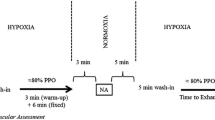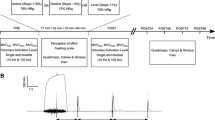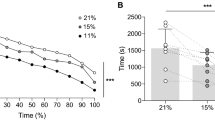Abstract
In order to test our hypothesis that muscle condition has an effect on the cognition of self-motion and consequently on the ventilatory response during exercise, six healthy subjects performed a moderate incremental exercise test (IET) on a cycle ergometer under two conditions [resistance exercise condition (REC) and control condition (CC)]. In the REC, resistance exercise (30 incline leg presses) was conducted during two sessions scheduled at 48 and then 24 h prior to the IET. For the CC, the subjects were instructed to refrain from participating in strenuous exercise for a period of 2 days prior to the IET. In the IET, the workload was increased from 78 to 118 watts in steps of 8 watts every 3 min. Although the ventilatory response during the IET was significantly higher in the REC than in the CC, there were no significant differences in cognitive indexes (RPE and awareness of change in workload) between the two conditions. In addition, the magnitude of muscle soreness was significantly higher in the REC than in the CC. However, the level of soreness in the REC was very low, and there were no significant differences in blood lactate concentration and integrated EMG between the two conditions. These results suggest that a change in peripheral neural reflex is the primary cause of increased ventilatory response to moderate exercise after resistance exercise, although the role of a cognitive element cannot be absolutely excluded.



Similar content being viewed by others
References
Adreani CM, Hill JM, Kaufman MP (1997) Responses of group III and IV muscle afferents to dynamic exercise. J Appl Physiol 82:1811–1817
Amann M, Dempsey JA (2008) Locomotor muscle fatigue modifies central motor drive in healthy humans and imposes a limitation to exercise performance. J Physiol 586:161–173
Asmussen E, Johansen SH, Jørgensen M, Nielsen M (1965) On the nervous factors controlling respiration and circulation during exercise experiments with curarization. Acta Physiol Scand 63:343–350
Bell HJ (2006) Respiratory control at exercise onset: an integrated systems perspective. Respir Physiol Neurobiol 152:1–15
Bell HJ, Feenstra W, Duffin J (2005) The initial phase of exercise hyperpnoea in humans is depressed during a cognitive task. Exp Physiol 90:357–365
Borg G (1982) Psychophysical bases of perceived exertion. Med Sci Sports Exerc 14:377–381
Braun WA, Dutto DJ (2003) The effects of a single bout of downhill running and ensuing delayed onset of muscle soreness on running economy performed 48 h later. Eur J Appl Physiol 90:29–34
Carson RG, Riek S, Shahbazpour N (2002) Central and peripheral mediation of human force sensation following eccentric or concentric contractions. J Physiol 539:913–925
Casaburi R, Whipp BJ, Wasserman K, Beaver WL, Koyal SN (1977) Ventilatory and gas exchange dynamics in response to sinusoidal work. J Appl Physiol 42:300–311
Cherniack NS (2007) Commentary on “Homeostasis of exercise hyperpnea and optimal sensorimotor integration: the internal model paradigm” by Poon et al. Respir Physiol Neurobiol 159:14–17
Davies RC, Eston RG, Poole DC, Rowlands AV, DiMenna F, Wilkerson DP, Twist C, Jones AM (2008) Effect of eccentric exercise-induced muscle damage on the dynamics of muscle oxygenation and pulmonary oxygen uptake. J Appl Physiol 105:1413–1421
Davies RC, Rowlands AV, Eston RG (2009) Effect of exercise-induced muscle damage on ventilatory and perceived exertion responses to moderate and severe intensity cycle exercise. Eur J Appl Physiol 107:11–19
Dempsey JA (2006) Challenges for future research in exercise physiology as applied to the respiratory system. Exerc Sport Sci Rev 34:92–98
Fink GR, Adams L, Watson JDG, Innes JA, Wuyam B, Kobayashi I, Corfield DR, Murphy K, Jones T, Frackowiak RSJ, Guz A (1995) Hyperpnoea during and immediately after exercise in man: evidence of motor cortical involvement. J Physiol 489:663–675
Gleeson M, Blannin AK, Walsh NP, Field CNE, Pritchard JC (1998) Effect of exercise-induced muscle damage on the blood lactate response to incremental exercise in humans. Eur J Appl Physiol 77:292–295
Goodwin GM, McCloskey DI, Mitchell JH (1972) Cardiovascular and respiratory responses to changes in central command during isometric exercise at constant muscle tension. J Physiol 226:173–190
Haouzi P (2006) Theories on the nature of the coupling between ventilation and gas exchange during exercise. Respir Physiol Neurobiol 151:267–279
Haouzi P, Chenuel B (2005) Control of arterial Pco2 by somatic afferents in sheep. J Physiol 569:975–987
Haouzi P, Hill JM, Lewis BK, Kaufman MP (1999) Response of group III and IV muscle afferents to distension of the peripheral vascular bed. J Appl Physiol 87:545–553
Hotta N, Sato K, Sun Z, Katayama K, Akima H, Kondo T, Ishida K (2006) Ventilatory and circulatory responses at the onset of exercise after eccentric exercise. Eur J Appl Physiol 97:598–606
Hotta N, Yamamoto K, Katayama K, Ishida K (2009) The respiratory response to passive and active arm movements is enhanced in delayed onset muscle soreness. Eur J Appl Physiol 105:483–491
Kaufman MP, Rybicki KJ (1987) Discharge properties of group III and IV muscle afferents: their responses to mechanical and metabolic stimuli. Circ Res 61:I60–I65
Marcora S (2009) Perception of effort during exercise is independent of afferent feedback from skeletal muscles, heart, and lungs. J Appl Physiol 106:2060–2062
McKay BR, Paterson DH, Kowalchuk JM (2009) Effect of short-term high-intensity interval training vs. continuous training on O2 uptake kinetics, muscle deoxygenation, and exercise performance. J Appl Physiol 107:128–138
Newham DJ, Jones DA, Edwards RHT (1983) Large delayed plasma creatine kinase changes after stepping exercise. Muscle Nerve 6:380–385
Poon CS, Tin C, Yu Y (2007) Homeostasis of exercise hyperpnea and optimal sensorimotor integration: the internal model paradigm. Respir Physiol Neurobiol 159:1–13
Shea SA (1996) Behavioural and arousal-related influences on breathing in humans. Exp Physiol 81:1–26
Sperry RW (1950) Neural basis of the spontaneous optokinetic response produced by visual neural inversion. J Comp Physiol Psychol 43:482–489
Thornton JM, Guz A, Murphy K, Griffith AR, Pedersen DL, Kardos A, Leff A, Adams L, Casadei B, Paterson DJ (2001) Identification of higher brain centres that may encode the cardiorespiratory response to exercise in humans. J Physiol 533:823–836
Twist C, Eston RG (2009) The effect of exercise-induced muscle damage on perceived exertion and cycling endurance performance. Eur J Appl Physiol 105:559–567
Von Holst E (1954) Relations between the central nervous system and peripheral organs. Br J Animal Behavior 2:89–94
Waldrop TG, Iwamoto GA, Haouzi P (2006) Point:counterpoint: supraspinal locomotor centers do/do not contribute significantly to the hyperpnea of dynamic exercise. J Appl Physiol 100:1077–1083
Ward SA (1994) Peripheral and central chemoreceptor and control of ventilation during exercise in humans. Can J Appl Physiol 19:305–333
Ward SA (2007) Ventilatory control in humans: constraints and limitations. Exp Physiol 92:357–366
Whipp BJ, Ward SA (1991) The coupling of ventilation to pulmonary gas exchange during exercise. In: Whipp BJ, Wasserman K, Dekker (eds) Pulmonary physiology and pathophysiology of exercise, New York, pp 271–307
Yunoki T, Matsuura R, Arimitsu T, Yamanaka R, Kosugi S, Lian CH, Yano T (2009) Effects of awareness of change in load on ventilatory response during moderate exercise. Respir Physiol Neurobiol 169:69–73
Acknowledgments
This study was supported in part by the Hokkaido Amateur Sports Association (Sports Science committee of Hokkaido).
Author information
Authors and Affiliations
Corresponding author
Additional information
Communicated by Susan A. Ward.
Rights and permissions
About this article
Cite this article
Yunoki, T., Arimitsu, T., Yamanaka, R. et al. Ventilatory response to moderate incremental exercise performed 24 h after resistance exercise with concentric and eccentric contractions. Eur J Appl Physiol 111, 1769–1775 (2011). https://doi.org/10.1007/s00421-010-1801-3
Received:
Accepted:
Published:
Issue Date:
DOI: https://doi.org/10.1007/s00421-010-1801-3




